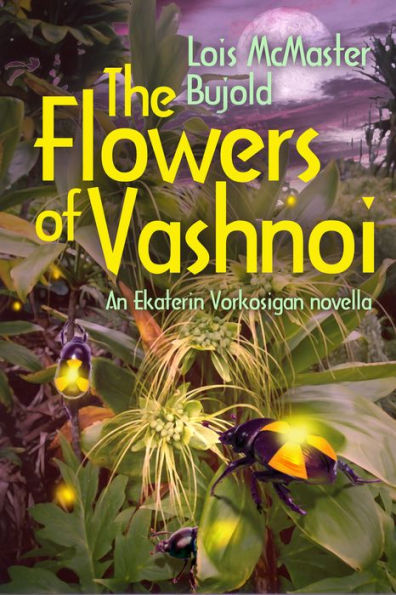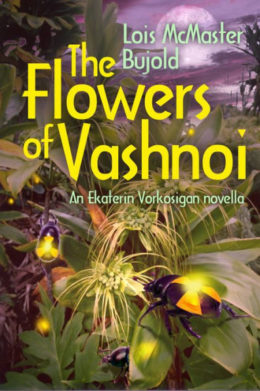The Flowers of Vashnoi is the most recent Vorkosigan novella. It is set between Captain Vorpatril’s Alliance and Cryoburn. It’s a short adventure focusing on Ekaterin, with Enrique in a major supporting role. While carrying out a research study on bugs that process radioactive waste, Ekaterin and Enrique find a family of mutants hiding in the contaminated area outside the ruins of Vorkosigan Vashnoi. The Flowers of Vashnoi came out last year in the same week as my birthday, which is irrelevant to any and all readers whose birthday isn’t in the same week as mine, roughly 51/52 of literate humanity, but I mention it anyway because I regard the book as a present. To me. I know Bujold didn’t write it for me, but she wrote it and I’m blogging about it, and here we are.
And because of that, it feels a little weird to be blogging about this book. You’re not supposed to dissect presents. You’re supposed to say thank you and be properly grateful and carry your present off to read and appreciate. I did all of those things. I love it and I appreciate it, and I’m also a little skeptical about it.
I love how much Enrique is in this book. There’s been some discussion in the comments from time to time about the possibility that Enrique is autistic. I have tended not to see him this way, but I don’t want to take an autistic character away from readers who want to see one—Enrique can be autistic if you want him to. My personal inclination has been to see him as a fish out of water. People can be autistic and be in unfamiliar surroundings at the same time. Enrique seems more comfortable and more confident in Flowers than he did back in A Civil Campaign.
The shift in Enrique’s comfort level is at least partly due to his having spent more time on Barrayar and gotten to know Ekaterin better. He also seems to have established a comfort zone with Miles. I think that part of this shift is also attributable to Enrique getting to do more microbiology in this book, and also some hard-core bad-assery on the lab safety front. I was very excited by the microbiology and lab safety here.
To follow up, I interviewed my cousin, Dr. Iain Cheeseman, who has a PhD in molecular and cell biology. I asked him about Enrique’s work on insects that use their gut bacteria to process radioactive waste. He said that’s totally a thing that scientists are working on now. Having gotten the microbiology part of the interview out of the way, I plunged on into lab safety. We were on the phone, so it was a little hard to be certain, but Iain appeared mildly confused by my focus on fire fighting. He informed me that the risk of fire in a twenty-first century microbiology lab is almost zero. Apparently, the bigger risk is that you’re going to let a genetically engineered organism loose in the municipal sewer system. That sounds a little like the concerns some blog readers had about the mycoborer in Captain Vorpatril’s Alliance. And just so you know, the city of Cambridge requires a lot of safety protocols around the use of recombinant DNA! When I asked Iain how much training the average microbiologist gets in fire suppression, he informed me that scientists who work in his building go through a safety briefing that includes pointing out the location of the fire extinguishers and being told what to do when the fire alarm goes off.
From this I infer that, while the field of microbiology hasn’t outwardly changed that much in however many centuries there are between now and Enrique, it has somehow become a lot more flammable. Or possibly, Escobar is making everyone who needs any kind of safety training at all go through the same safety procedures course. Both of these possibilities are exciting. I’m sure there is a wide range of more dangerous lab procedures that someone will invent at some point—maybe they will finally refine the thing where the lab material gets struck by lightning like it does in Gothic novels!—and also Enrique might be just as useful in earthquakes or shipwrecks as he is when someone lights a hut on fire in the radioactive wasteland surrounding Vorkosigan Vashnoi! The Galactic Nexus is full of intriguing possibilities.
I’m also thrilled to see Ekaterin’s perspective again. Marriage to Miles had made some things easier for her. But also, she’s married to Miles. He’s a great guy. He’s a lot, you know? In one notable scene in this book, he encourages the twins to throw food at the cat, and then leaves the nanny to clean up. This may be literature’s most perfect example of managing adult ADHD through staffing. Miles is also a smidge over-protective, in a slightly smothering kind of way. Ekaterin is good at managing people, so she’s good at managing Miles. Showing Ekaterin’s Miles-management skills is a nice set-up for showing her interactions with the mutant children she meets slightly later.
As you may recall, Vorkosigan Vashnoi was the target of a major Cetagandan nuclear strike. The city was completely destroyed. Approximately a quarter of a million people died. The city and the surrounding area are now a nuclear fallout zone. Ekaterin, Miles, and Enrique visit it, along with a ranger, Vadim, in order to carry out a study on a new strain of Enrique’s bugs that collect nuclear waste. In order to differentiate them from other bugs and make them easier to find, the radbugs have a little nuclear waste symbol on them, and it glows. This has attracted the attention of some children living in the fallout zone. No one is supposed to be there, but Ma Roga was convicted of murder (along with a gang of other people) and she returned to the fallout zone to live with her son, Boris. She then discovered that people were abandoning mutated infants in the fallout zone. For years, she has raised the ones she could and buried the ones who died in her makeshift cemetery. One of her foster children, an albino boy named Ingi, has been stealing Enrique’s bugs from the test site to give to his sister, Jadwiga, who thinks the bugs are pretty.
And here, I need to start dissecting things, because Barrayar’s problems never seem to go away. Jadwiga was born with six fingers, and she was born to people who had the ability to transport a baby some distance—they didn’t live in the fallout zone—but rather than seeking testing and treatment for that relatively common congenital malformation, they abandoned their infant. Ingi has albinism. Their parents left them in a fallout zone to die. And now Jadwiga has cancer—she has an obvious growth on her neck. Vadim is Jadwiga’s brother, and he has been helping Ma Roga for years by bringing food and supplies for her and her foster children. That’s nice, for a definition of nice that considers that there are a number of more substantial and constructive paths that he could take in this situation since he is (now) an adult and a government employee. Jadwiga’s need for medical treatment has been obvious for some time. I’m going to guess over a year. Vadim is bringing food. That’s not going to help when his sister can’t swallow. These are the situations that make me want to scream—Barrayar, what the FUCK?
Buy the Book


The Flowers of Vashnoi
Ekaterin, being a lady who understands her feudal obligations, is not content to feed the children sandwiches, re-collect the radioactive bugs, and go her merry way. She wants to take the children to a hospital. She knows a good one. She’s very sympathetic to their concerns about the fate of their livestock and arranges for them to be relocated to the Butterbug Ranch. But change comes hard. Ma Roga responds to this situation by trying to kill herself and her children and set her cottage on fire. (This is where Enrique gets to show off his fire rescue skills.) In Ma Roga’s defense, what she knows about the world outside the fallout zone around Vorkosigan Vashnoi is that people leave infants with mutations to die. It’s a harsh, cruel place. I find this a poor excuse for attempted murder. Ekaterin stuns Ma Roga and calls for help. Everyone goes to the hospital, and Ma Roga is arrested again.
In the hospital (Ekaterin is being treated for radiation exposure, but it’s prophylaxis—she’s OK) Miles expresses hope for everyone involved. Miles lives in the bravest, newest world Barrayar has to offer. He is practically made of hope. In his eyes, the kids have bright futures, given some remedial education and appropriate medical treatment. He’s optimistic about Ma Roga as well.
Miles’s inclination is to see the best in everyone. His mother did that too. Maybe I should be more open to Miles’s optimism, because these stories are all about redemption. One reason I love this book is that although he isn’t in the story, Aral is alive while it’s going on—I can read this story and think that at this moment, somewhere in the Nexus, there is a living breathing Aral. Aral voluntarily confessed to three murders, and I love him anyway. Bothari was a war criminal, a rapist, and a murderer, and I thought he was on an interesting trajectory. But I’m not OK with Count Piotr and I’m not OK with Ma Roga. Miles forgives because he sees the best in everyone. Miles deals with a lot of murderers. Like his mother, he trusts beyond reason. I know he thinks it will get him results beyond hope. But he’s only just laid eyes on Ma Roga! And the crimes she committed weren’t committed against him. It’s not Miles whose forgiveness Ma Roga needs. Who is he to be holding out high hopes for her future, when he’s only just read up on her past? Sometimes I can’t be the person the Vorkosigan series asks me to be—I’m not that forgiving. Some things are a bridge too far.
Cryoburn is going to continue the theme of how societies deal with the people they don’t want. We’ll dive into that next week.
Ellen Cheeseman-Meyer teaches history and reads a lot.










